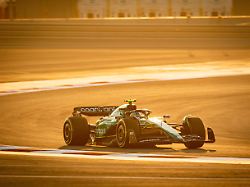Mega event with crazy travel routes
Every Formula 1 race should be “like a Super Bowl”
02/27/2023, 3:08 p.m
More races in one year than ever before. As much show as never before. Plus automobile giants queuing up to be allowed to participate. Formula 1 is booming. The majority owner fuels the pursuit of gigantism. But that has its downsides.
Six years ago there was a vision. Some spoke of utopia. Every single Formula 1 race, according to the new majority owners of Liberty Media, should be “like a Super Bowl”. So a mega event, electrifying, great sport, great show.
Before the start of the 2023 season, you have to say: It doesn’t get much bigger than that. There are people interested in at least 30 races, the grandstands are full. Automobile giants are lining up, Audi and Ford have already secured their place for 2026. Cadillac would like to join, preferably with the US institution Andretti.
Anyway, the USA: There are three races this year in the land of unlimited opportunities, which has been strangers to the premier class for so long. The highlight is the inaugural Grand Prix on the Strip in Las Vegas (November 18). “It will be one of the biggest, if not the biggest, race,” enthuses record world champion Lewis Hamilton.
Formula 1 revenue is growing steadily
The Netflix series “Drive to Survive” – the fifth season has been online for a few days – has certainly not harmed Formula 1. But a lot has also gone right within the PS circus. The days when you could buy a shambles with attached racing car factory for a symbolic dollar are over. “I don’t think you can buy a team for less than £500m today,” said Formula 1 CEO Greg Maffei.
The budget cap introduced in 2021 has proven to be salutary. Even small violations can result in painful penalties, Red Bull has found out: The world champion racing team is hardly allowed to test in the wind tunnel this year.
At the same time, the income from the series is growing steadily, in 2021 it was almost two billion euros. Of course, the money also goes into the coffers of the ten teams. And they want to keep the circle of profiteers as exclusive as possible, which recently led to tensions with the world association FIA, which would like to have up to twelve racing teams there.
Travel itineraries do not fit with carbon neutrality
However, the income is only so high because Formula 1 is operating at the limit. A record season of 23 races begins in Bahrain on Sunday (4 p.m. / Sky and in the ntv.de live ticker). It will hardly stay that way. Kyalami in South Africa is expected back in 2024. China also has its place contractually secured. For this, locations that do not (or cannot) transfer so much entry fee would have to give way. The cult track Spa-Francorchamps wobbles a lot, even the legendary street circuit in Monaco had to stretch. Germany has been out for three years, and a return is currently hardly imaginable.
However, if the former core market of Europe, with its comparatively short distances, becomes ever smaller, CO2 emissions will also increase. Transport and logistics already make up the lion’s share at 70 percent – pure racing only around one percent.
This year, more than 120,000 kilometers come together, if you only add up the journeys from race to race. Of course, the drivers and other staff also travel home between the races. The motorsport premier class, which has set itself the goal of CO2 neutrality by 2030 and is thus doing PR, can still make adjustments, especially when it comes to calendar design. In the spring, for example, it goes from Melbourne via Baku and Miami to Imola.
More income or more CO2?
A regionalized calendar could save CO2, but it would also cost income, because many promoters pay for a desired date. “The weather has a direct impact on our sales figures,” says Arif Rahimov, promoter of the Azerbaijan Grand Prix.
As a technological sport, Formula 1 relies primarily on innovation. In 2022, an E10 fuel was introduced, consisting of ten percent sustainable ethanol. From 2026, the plan is to run on 100 percent sustainable fuel. The goal: The benefit to the planet must outweigh the damage from the show. Then it can continue unabated.
